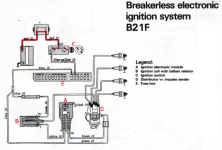Souped
Well-known member
- Joined
- Nov 6, 2016
Hey y'all,
I have an 83 with 2.0 that I'd like to switch from the dead Chrysler ignition to the CIS era breakerless. I'm not amazing with wiring, so I think I've made it as far as I can with old threads and wiring diagrams. I am replacing the whole ignition, so there's no weird mix and match. Green book wiring diagram shows 4 wires from the breakerless ignition box, but there are 6 poles. The diagram I'm using is for a 1979.
From the breakerless box I have:
1. 2 pole distrutor plug - that's easy enough
2. 2 pole with...
...blue - run to blue wire on dash harness from fuse 11
...blue jumper - run to ballast resistor input
...brown - Not 100% here. Found an old thread that said to run this to the connector from fuse 11, which runs to the starter solenoid in the Chrysler ignition.
3. 1 pole with 1 brown and 1 white wire. In the green book wiring diagram, it looks like both of these run to the coil negative for CIS. The old thread I found splits these, sends the brown to the ballast resistor outlet and running a jumper to the starter solenoid. The white wire would run to the "dash harness tach drive (grey)". Also mentions jumpering this connection to the "engine harness connection" under the crank pulley, but I'm not sure what that is. Also mentions running another ground from this point other than the ground from the ignition box. I'm confused by this last part because I don't see this on the fuel or ignition wiring diagrams.
In the green book LH wiring diagram. It looks like the ignition signal goes from the coil negative to ECU pin 1 and grounds at pin 5. This is also the only grey wire on the diagram. Is there any reason I can't keep the existing wire running from the coil negative to ECU and plug the white/brown connector to the coil negative, where it looks like it would run on a CIS car? Would the difference in resistance measurements between the LH and CIS coils have anything to do with this?
I'm also confused about running the brown wire from the single pole plug to the ballast resistor outlet. My wiring diagram doesn't show this wire at all. It shows 2 wires from the ballast resistor outlet, one to the starter solenoid and one to the coil positive.
I have an 83 with 2.0 that I'd like to switch from the dead Chrysler ignition to the CIS era breakerless. I'm not amazing with wiring, so I think I've made it as far as I can with old threads and wiring diagrams. I am replacing the whole ignition, so there's no weird mix and match. Green book wiring diagram shows 4 wires from the breakerless ignition box, but there are 6 poles. The diagram I'm using is for a 1979.
From the breakerless box I have:
1. 2 pole distrutor plug - that's easy enough
2. 2 pole with...
...blue - run to blue wire on dash harness from fuse 11
...blue jumper - run to ballast resistor input
...brown - Not 100% here. Found an old thread that said to run this to the connector from fuse 11, which runs to the starter solenoid in the Chrysler ignition.
3. 1 pole with 1 brown and 1 white wire. In the green book wiring diagram, it looks like both of these run to the coil negative for CIS. The old thread I found splits these, sends the brown to the ballast resistor outlet and running a jumper to the starter solenoid. The white wire would run to the "dash harness tach drive (grey)". Also mentions jumpering this connection to the "engine harness connection" under the crank pulley, but I'm not sure what that is. Also mentions running another ground from this point other than the ground from the ignition box. I'm confused by this last part because I don't see this on the fuel or ignition wiring diagrams.
In the green book LH wiring diagram. It looks like the ignition signal goes from the coil negative to ECU pin 1 and grounds at pin 5. This is also the only grey wire on the diagram. Is there any reason I can't keep the existing wire running from the coil negative to ECU and plug the white/brown connector to the coil negative, where it looks like it would run on a CIS car? Would the difference in resistance measurements between the LH and CIS coils have anything to do with this?
I'm also confused about running the brown wire from the single pole plug to the ballast resistor outlet. My wiring diagram doesn't show this wire at all. It shows 2 wires from the ballast resistor outlet, one to the starter solenoid and one to the coil positive.



